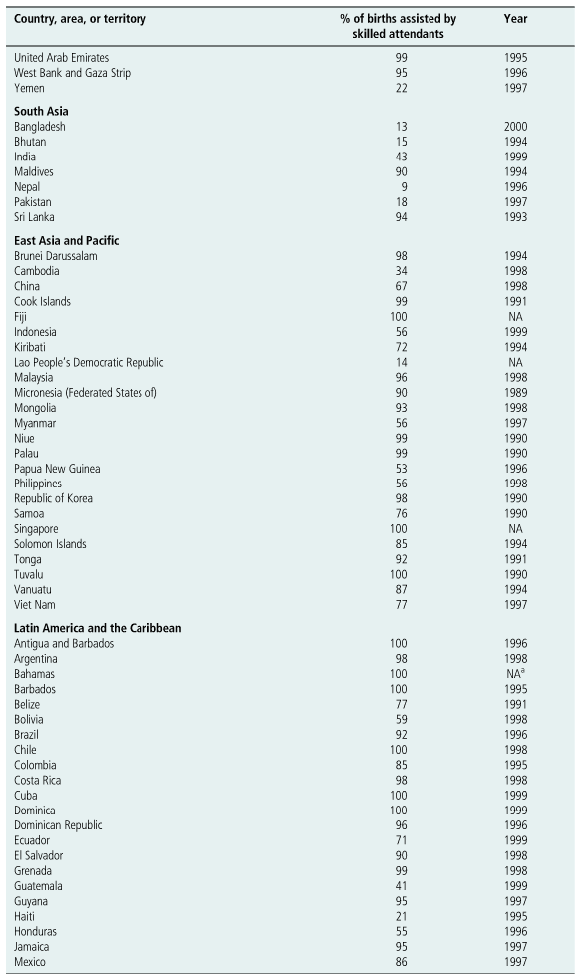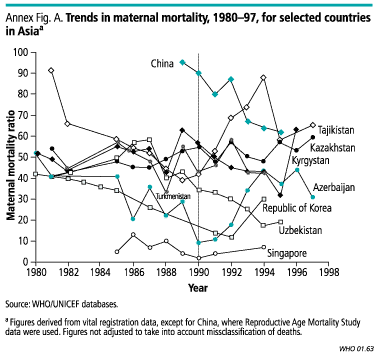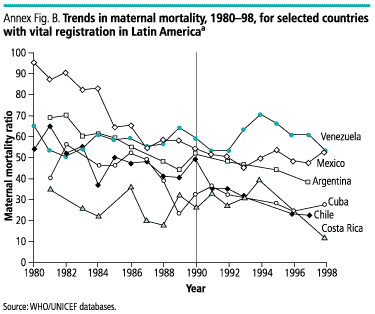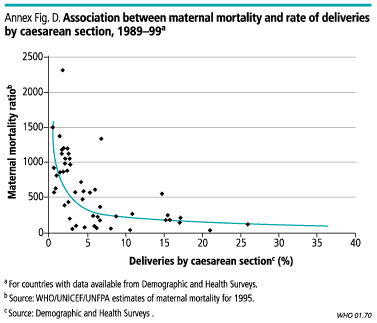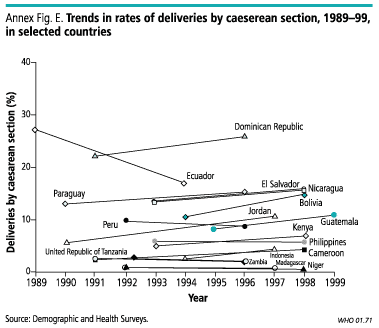Maternal mortality at the end of a decade: signs of progress?
Carla AbouZahr1 & Tessa Wardlaw2
ABSTRACT: Maternal mortality is an important measure of womens health and indicative of the performance of health care systems. Several international conferences, most recently the Millennium Summit in 2000, have included the goal of reducing maternal mortality. However, monitoring progress towards the goal has proved to be problematic because maternal mortality is difficult to measure, especially in developing countries with weak health information and vital registration systems. This has led to interest in using alternative indicators for monitoring progress. This article examines recent trends in two indicators associated with maternal mortality: the percentage of births assisted by a skilled health care worker and rates of caesarean delivery. Globally, modest improvements in coverage of skilled care at delivery have occurred, with an average annual increase of 1.7% over the period 198999. Progress has been greatest in Asia, the Middle East and North Africa, with annual increases of over 2%. In sub-Saharan Africa, on the other hand, coverage has stagnated. In general, caesarean delivery rates were stable over the 1990s. Countries where rates of caesarean deliveries were the lowest and where the needs were greatest showed the least change. This analysis leads us to conclude that whereas there may be grounds for optimism regarding trends in maternal mortality in parts of North Africa, Latin America, Asia, and the Middle East, the situation in sub-Saharan Africa remains disquieting.
Keywords Maternal mortality/trends; Process assessment (Health care)/trends; Midwifery/statistics; Cesarean section/ statistics; Vital statistics; Registries (source MeSH).
Mots clés Mortalité maternelle/orientations; Evaluation méthodes santé/orientations; Profession sage-femme/ statistique; Césarienne/statistique; Statistique démographique; Registre (source: INSERM).
Palabras clave Mortalidad materna/tendencias; Evaluación de proceso (Atención de salud)/tendencias; Tocología/estadística; Cesárea/estadística; Estadísticas vitales; Sistema de registros (fuente: BIREME).
Introduction
During the 1990s, a number of international conferences set goals for a reduction of maternal mortality. In 1999, during appraisal of the implementation of the Cairo Programme of Action, a reduction in maternal mortality was reiterated to be a high priority and countries agreed to strengthen information systems further to permit regular monitoring of maternal mortality (1). The reduction in maternal mortality was adopted as an International Development Goal by the United Nations (UN), the Organisation for Economic Cooperation and Development, the International Monetary Fund, and the World Bank (2, 3) and endorsed by 149 heads of state at the Millennium Summit in 2000 (4). This unprecedented global consensus creates additional stimulus for accurate monitoring of progress in the attainment of this goal in individual countries and across the world.
Goal setting presupposes the ability to monitor progress; unfortunately, in the case of maternal mortality, this has proved to be a greater challenge than might have been anticipated. With the 1990s now behind us, and with several years of country data upon which to draw, this is an opportune moment to assess what progress has been made. In this paper, we present what is currently known about trends in maternal mortality in developing countries. We also present data on trends in two indicators related to maternal mortality: the percentage of pregnant women who have the help of a skilled attendant during labour and childbirth and the percentage of deliveries carried out by caesarean section.
The maternal mortality ratio: a problematic indicator to measure
Ascertaining progress in the efforts to reduce maternal mortality is problematic because maternal mortality is difficult to measure (5). The definition in the tenth revision of the International statistical classification of diseases and related health problems includes deaths due to both direct obstetric causes and to conditions aggravated by pregnancy or delivery (6). In countries with statistically developed systems, the conventional source of information about maternal mortality is the civil registration system, which records deaths by cause as well as recording live births on a continuous basis. Even in such settings, however, maternal deaths are invariably found to be underrecorded in official statistics as a result of misclassification of cause (711). In countries that are less statistically developed, errors in both numbers of deaths and attribution of cause may result in biased measures of maternal mortality derived from vital registration.
Vital registration systems in most developing countries are absent or inadequate and it is necessary to estimate maternal mortality through household surveys. But even where overall levels of maternal mortality are high, maternal deaths are relatively rare events, limiting the applicability of sample survey methods. The most commonly used measure, the maternal mortality ratio (MMR), expresses maternal deaths per 100 000 live births, yet MMRs rarely exceed 1000, or one per 100 live births. Even with large sample sizes, the standard errors of the MMR will inevitably be large. Large-scale surveys are extremely expensive and thus not feasible where resources are limited (1012). The sisterhood method is a survey-based measurement technique that substantially reduces sample size requirements because it obtains information by interviewing respondents about the survival of all their adult sisters. Although sample size requirements are reduced, the problem of wide confidence intervals remains and therefore the technique is not appropriate for monitoring. Furthermore, the method provides a retrospective rather than a current estimate (13). Because of such problems, the use of the ratio as the sole indicator of maternal mortality is no longer considered appropriate in settings where survey techniques have to be used.
Measuring maternal mortality using civil registration
Where data on levels of maternal mortality are available on a regular basis from routine vital statistics, they can be used for monitoring trends. In practice, however, only a small number of countries, accounting for under a quarter of the worlds births (and less than 7% of births if China is excluded), have data on trends in maternal mortality derived from the civil registration system. All of these countries have relatively low levels of maternal mortality, at under 100 per 100 000 live births since the early 1980s. Furthermore, there are a number of issues that must be borne in mind when using these data. Although ratios derived from routine vital statistics are not subject to huge margins in standard errors in the same way as those derived using survey methodologies, all the evidence indicates that there is significant underreporting and misclassification of maternal deaths. The latter is of particular significance, as registration systems are known to fail routinely to identify correctly a proportion of maternal deaths (14). The deaths most often misclassified in routine reporting include those associated with abortion (especially where it is illegal); early pregnancy deaths (resulting from ectopic or molar pregnancy), where the pregnancy may have been unknown to the woman or her family; indirect maternal deaths (e.g. due to malaria, anaemia, tuberculosis, hepatitis, or cardiovascular disease); and deaths that occur some time after the end of pregnancy, especially where the death occurs in a non-obstetric hospital ward, for example, in an intensive care or other specialized unit (9, 1517).
Trends in Asia and Latin America
Annex Fig. A and Annex Fig. B (available on our web site: http://www.who.int/bulletin) show maternal mortality trends derived from civil registration data in selected developing countries in Asia and Latin America, respectively (countries classified by the UN Statistics Offices as having complete registration, i.e. 90% or more of adult deaths recorded). Annex Fig. A also includes trend data for China, where Reproductive Age Mortality Study (RAMOS) data have been used to estimate maternal mortality since 1989.
Malaysia, Sri Lanka, and Thailand also have data on maternal mortality derived from routine reporting coupled, in recent years, with various methods of triangulation (i.e. using different information sources to cross-check for completeness) in order to reduce misclassification of maternal deaths and improve the completeness of reporting. We have not included data for these three countries because improved case ascertainment in the more recent data renders any trend analysis problematic. Apparent increases in levels of maternal mortality during the 1990s, notably in Malaysia and Thailand, are thought to reflect improved data collection as a result of the triangulation rather than a real increase in the rates. Trends from vital registration data are not shown for Mauritius, the only African country classified by the UN as having complete registration, because the actual numbers are very small.
For the countries included in this analysis, we have assumed that the overall proportion of maternal deaths missed in routine reporting has remained relatively stable, given the absence of efforts to improve case finding. However, there is no evidence to support this assumption and it is conceivable that the quality of vital registration has either improved or deteriorated over the years analysed. These trend data cannot be assumed to capture fully the true levels of maternal mortality because of the problems of underreporting and misclassification. In Argentina and Mexico, for example, small-scale studies in major urban areas have concluded that officially reported levels of maternal mortality may be underreported by as much as 50% (18).
Bearing all these caveats in mind, significant reductions in registered maternal mortality have occurred in the countries analysed. However, most of the decline took place prior to 1990, the baseline date from which progress is measured here. Only Argentina, Chile, China, Costa Rica, and Uzbekistan were able to demonstrate sustained reductions in maternal mortality over the 1990s. Elsewhere, there appears to have been a relative stagnation in maternal mortality ratios since 1990. It is important to stress that Argentina, Chile, China, Costa Rica, and Uzbekistan cannot be considered representative of trends in developing countries as a whole. All have levels of maternal mortality that are low for developing countries, at less than 100 maternal deaths per 100 000 live births.
Trends in Eastern Europe
Annex Fig. C (available on our web site: http://www.who.int/bulletin) shows trends in maternal mortality in some countries of Eastern Europe which are thought to have relatively efficient systems of vital registration. The apparent transient increases in some countries (e.g. Latvia) may be the result of random fluctuations due to the small numbers involved or may be due to improved case reporting. In Romania, the dramatic fall in maternal mortality observed in 198990 reflects the liberalization of the law regarding availability of safe abortion. Prior to 1989, strongly pronatalistic policies, lack of reliable contraception, prohibition of abortion, and economic difficulties for ordinary people combined to result in extremely high levels of abortion-related mortality (19). Although the situation appears to have stabilized somewhat since 1990, there are marked differences between levels of maternal mortality in these countries of Eastern Europe and levels in countries of the European Union (data not shown).
Process indicators
In countries where maternal mortality is measured using household surveys, the margins of uncertainty are such that it is not possible to draw firm conclusions about the directions of trends. For assessing progress in these countries, process indicators are needed for regular monitoring. Good process indicators are closely correlated with the outcome of interest, but have a number of advantages over outcome indicators: they are generally easier and cheaper to collect and are more sensitive to change, and are thus very useful for regular and short-term monitoring. Experience has shown that reducing maternal mortality depends critically on the availability and use of obstetric care for managing complications. Unfortunately, data on this remain extremely limited at present. We are therefore proposing two other indicators for which data are more widely available, namely the percentage of deliveries assisted by a skilled attendant and those carried out by caesarean section.
Assistance of a skilled attendant at delivery
The percentage of births assisted by a skilled attendant is one potential process indicator and there is evidence of its strong association with levels of maternal mortality (20, 21). There is a clear clinical justification for the presence of a skilled attendant at delivery, as this may reduce both the incidence of complications and case fatality (22). However, correlation does not necessarily imply causation. Unequivocal epidemiological evidence for the impact of skilled attendants at delivery on reducing maternal mortality is lacking. The evidence in favour of a causal link is, for the moment, largely circumstantial. Moreover, the apparent simplicity of the indicator tends to obscure the complex reality of care during childbirth. There are large differences in the skills, equipment, and supplies needed for the appropriate care and management of normal compared with complicated deliveries. Graham, Bell, & Bullough have shown that the correlation between maternal mortality reduction and assistance of a skilled attendant appears to be stronger when the attendants are doctors rather than nurses or midwives (23), a finding that could be a reflection of better access to essential obstetric care services. Although this issue is too complex to address here, it is important to bear in mind and caution is needed in interpreting the data in this paper.
Despite these concerns, the skilled-attendant indicator has a number of advantages for monitoring purposes, including the fact that data are widely available for developing countries up to and including the year 2000. Currently, the source of the information is generally the Demographic and Health Surveys (DHS), PAPCHILD, or Reproductive Health Surveys. These use a standardized methodology and sampling framework and have strict criteria regarding the maintenance of data quality, thus enhancing the comparability of data between countries and over time. The DHS, PAPCHILD, and Reproductive Health Surveys subdivide birth attendants into doctors, nurses, midwives, or nurse-midwives, and trained traditional birth attendants. The latter initially acquire their ability either by delivering babies themselves or through apprenticeship to other traditional birth attendants, undergo subsequent extensive training, and are then integrated in the formal health care system. The remaining category comprises relatives, untrained traditional birth attendants, and no assistance. For these calculations, only doctors and nurses, midwives, and nurse-midwives who have the necessary midwifery skills are classified as skilled attendants.
Problems of definition. Like any crude measure, however, this indicator may hide important differences (e.g. between regions or socioeconomic groups). Moreover, while efforts are being made to standardize definitions of skilled attendants, there is doubt about the comparability of some of the results between countries and within a country at different time periods. One source of potential confusion is the differing interpretations of skilled attendant. The precise competencies of health care providers with various titles can be clarified only at the local level. This issue is particularly complex in Latin America where there appear to be discrepancies in the definition of the health workers classed as skilled attendants (e.g. parteras, comadronas, and dais). Moreover, the definitions have, in some cases, changed from one DHS to another, particularly in the definition of parteras. In order to avoid these problems, for countries in Latin America and the Caribbean, we have used the proportion of births taking place in a health care facility, for which the definitions are consistent from one survey to the next, rather than the less clearly defined term skilled attendant. This should not be taken to imply any recommendation as to the place of delivery; the decision is based on statistical considerations alone. For all other countries, we have followed the survey definition but have only included in our analysis only attendants described as doctors, nurses, midwives or nurse-midwives.
Apart from problems of definitions, there are other issues related to methods of data collection on skilled attendants at delivery. Concerns include the extent to which respondents can accurately report the levels of skills of the attendant and potential bias introduced by the fact that most household surveys report on live births, thus missing many adverse health outcomes, such as still births or miscarriages.
Despite such limitations, the indicator provides some useful information for comparing countries and studying recent trends. Annex Table A (available on our web site: http://www.who.int/bulletin) shows data available in January 2001 on assistance of skilled attendants at delivery for developing countries over the period 198999. Current estimates indicate that globally, skilled attendants assist only around 56% of births (WHO and UNICEF databases). The lowest levels in developing countries are in South Asia (29%) and sub-Saharan Africa (37%). The highest levels are in Latin America and the Caribbean (83%) and the Central and Eastern Europe/Commonwealth of Independent States regions (94%).
Trend data are not available for all developing countries. The trend information presented here represents only the subset of developing countries that have a minimum of two data points derived from sources using similar estimation methods, generally DHS surveys. Overall, these countries account for 76% of live births in developing countries, although this figure varies considerably by region. Given the imprecision of the data collection methodologies used to generate this indicator, it would be inappropriate to read too much into the apparent changes in coverage of care. Table 1 shows the annual rate of change in this indicator for major regional groupings. Because data are available for different years and cover a different time period for each country, we have adjusted trends to a common 10- year period: 198999. The observed rate of change was used to project data for the end points in 1989 and 1999. The regional averages are weighted by the numbers of live births.

Trends in coverage of care (assistance of skilled attendant) at delivery. The evidence shows that, in general, only modest improvements in coverage of care at delivery have occurred, with an average annual increase of 1.7% over the period 198999. In sub-Saharan Africa, there was no overall change over the period, despite improvements in some countries, notably Togo and Niger. On the other hand, countries of Asia, the Middle East, and North Africa show significant improvements, with average annual increases of 2.2% (Asia) and 2.5% (Middle East and North Africa).
Figs 13 show the evolution of skilled attendant data for selected developing countries from the early 1980s until the late 1990s. For Latin America and the Caribbean, as explained earlier, the trends in the percentage of births occurring in health care facilities is shown (Fig. 4). In Brazil, Jamaica, Jordan, Kuwait, Oman, Panama, and South Africa, there are relatively high levels of coverage with modest but positive growth. In contrast, in Bangladesh, Burkina Faso, Haiti, and Mali very low levels of coverage coincide with little change or even a decline. Niger and Yemen, though starting from a low baseline, have shown some improvements in coverage. Significant improvements can be observed in Bolivia, Egypt, Indonesia, Morocco, and Togo countries characterized in recent years by a determined and high-level commitment to address maternal mortality. In Egypt, for example, coverage at delivery increased from 35% to 61% over the period 198899. In Indonesia, the percentage of deliveries assisted by a skilled attendant increased from 36% in 1997 to 56% in 1999. In Morocco, coverage increased from 24% in 1984 to 40% in 1995. Significant increases in the percentage of births in health care facilities were observed in other countries such as Argentina, Ecuador, Honduras, and Mexico.
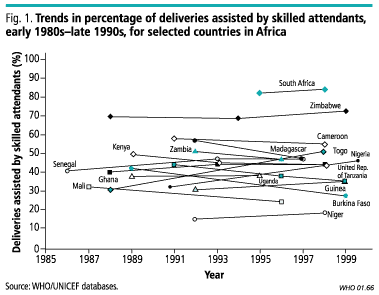

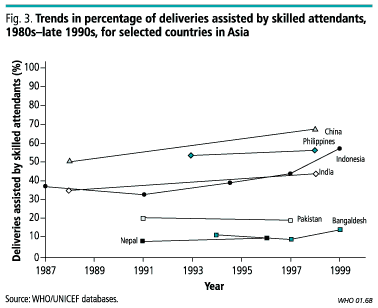
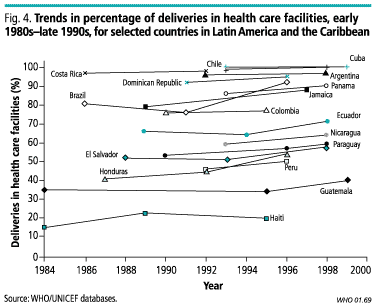
Countries with already high rates of coverage at delivery (e.g. Costa Rica, Cuba, Jordan, and Kuwait) appear to be making continuous progress. Countries with intermediate levels of coverage (e.g. Guinea, South Africa, Togo, Tunisia, and Zimbabwe) show ongoing, slow improvements. On the other hand, other countries (e.g. Burkina Faso, Cameroon, Kenya, Madagascar, Mali, United Republic of Tanzania, and Zambia) appear to have lost ground. Of the 17 sub-Saharan countries for which trend data are available, only six (Ghana, Guinea, Niger, Nigeria, Senegal, and Togo) have significantly increased levels of coverage since 1988. While acknowledging the uncertainties inherent in the data, the apparent stagnation in coverage shown by these results should alert national authorities to a potential problem.
Rate of caesarean delivery
Another process indicator, which was originally proposed for monitoring access to health care services, is the proportion of all deliveries carried out by caesarean section (24). The rationale for using this indicator as a proxy for maternal mortality is based on the premise that in the absence of surgical interventions such as caesarean delivery or hysterectomy, many women with serious obstetric complications (obstructed labour, eclampsia, or intractable haemorrhage) will die. It is important to be clear that increasing the rate of caesarean deliveries is not the goal; rather, the indicator can be used as a proxy for the extent to which health care facilities provide and women are able to gain access to this essential element of obstetric care. This indicator is controversial because caesarean delivery is sometimes overused or used for inappropriate indications, i.e. for reasons not related to preserving the life and health of mother or infant. The procedure can be convenient and lucrative for physicians but carries risks for the woman, particularly when conducted in less than optimal conditions. It also imposes additional costs for the woman and her family. UNICEF, WHO, and UNFPA guidelines recommend that, as a general rule, a minimum of 5% of deliveries are likely to require a caesarean section in order to preserve the life and health of mother or infant. Rates higher than 15% indicate inappropriate use of the procedure. It goes without saying that a study of the rates by themselves tells us nothing about whether the women who really needed a caesarean delivery actually had one. Such information can only be obtained through a detailed study of the indications for caesarean delivery in individual health care facilities.
The numbers of caesarean deliveries can be obtained from examination of health facility logbooks, but the information is very rarely collated at the national level. However, in recent years, DHS surveys have included questions about mode of delivery for women who had a live birth in the preceding five years. For a few countries, trend data on caesarean delivery are now available (data from DHS surveys, various years).
The relationship between rates of caesarean delivery and levels of maternal mortality is not simple. The maternal mortality estimates were developed by WHO and UNICEF using a range of predictor variables, but not including caesarean delivery rates. As shown in Annex Fig. D (available on our web site: http://www.who.int/bulletin), very high levels of maternal mortality (over 500 maternal deaths per 100 000 live births) are generally associated with low levels of caesarean delivery (5% or below). All countries with caesarean delivery rates below 2% have levels of maternal mortality above 500 per 100 000 live births. However, low levels of maternal mortality coexist with a wide range of caesarean delivery rates. In several countries with maternal mortality ratios below 100 per 100 000 live births, caesarean delivery rates were around 37%. It is possible that these low rates of caesarean delivery are associated with high levels of normal vaginal delivery, but it is impossible to ascertain this from the available DHS data.
In general, caesarean delivery rates were higher in countries of the Americas than in Africa and Asia. Particularly low levels of caesarean delivery less than 5% of all deliveries were found in Cameroon, Niger, Madagascar, and Zambia. Trends in caesarean delivery rates tended to be stable over the 1990s, although in Ecuador there appears to have been a rather substantial decline (Annex Fig. E, available on our web site: http://www.who.int/bulletin). In contrast, in Bolivia, the Dominican Republic, Guatemala, and Jordan, rates appear to have increased. For the other countries, the changes in levels were very small. What is particularly noteworthy is that it is precisely in those countries where rates of caesarean deliveries were the lowest and presumably where the needs were greatest that there was the least apparent change.
Conclusions
We have attempted to assess progress in the reduction of maternal mortality over the 1990s using both direct and proxy indicators. Where civil registration exists, temporal trends can be analysed for signs of progress, though care is required in evaluating the data because of the well-documented problems of incomplete registration and inaccuracy in cause-of-death attribution.
Disappointing rates of reduction in maternal mortality
Only a few developing countries, accounting for 24% of live births worldwide, have complete vital registration, according to the UN. In these countries, while there has been a decline in maternal mortality, most of the decrease took place during the 1970s and early 1980s. Since then, progress appears to have slowed despite the increased interest in the issue generated around the Safe Motherhood Initiative, which started in 1987 (19).
Increase in the use of medical care at deliveries, but still not worldwide
We have also analysed two process indicators: the percentage of births assisted by a skilled attendant and the rates of caesarean delivery. Taken together, they appear to show that while progress has been generally slow, most parts of the world have succeeded in increasing the use of medical care at deliveries. The exception is sub-Saharan Africa as a whole, where, despite progress in a few countries, in general coverage has stagnated or, in several countries, actually declined.
Currently available data do not permit us to establish clear and unequivocal links between trends in the percentage of deliveries assisted by a skilled attendant and maternal mortality. Like any other indicator, this represents a snapshot of a complex reality. Much more detailed information is needed, both with regard to how the indicator is measured, and also, perhaps more importantly, precisely what it means in different settings with regard to the level of care available to women with normal and complicated deliveries.
If the association between maternal mortality and the two indicators holds, however, the data currently available suggest that there may be grounds for optimism regarding trends in maternal mortality in parts of North Africa, Latin America, Asia, and the Middle East. In contrast, the situation in large parts of sub-Saharan Africa is disquieting, with unchanged or declining levels of coverage of skilled care for women during the crucial period of childbirth. This is a particular cause for concern in settings with high prevalence of HIV/AIDS, where the need for skilled care during labour and childbirth is critical.
Implications for the future
In 1999, at the Special Session of the UN General Assembly to mark five years after the International Conference on Population and Development held in Cairo, Egypt, it was agreed that all countries should strive to ensure that 80% of deliveries are assisted by a skilled attendant by 2005. Based on current trends, only countries of Latin America and the Caribbean will attain this goal (Fig. 5). Countries in the Middle East and North Africa will not reach the goal until around 2010 and Asian countries as a whole will fall short of the goal even in 2015. In sub-Saharan Africa, there is no overall sign of progress towards the 2015 goal.
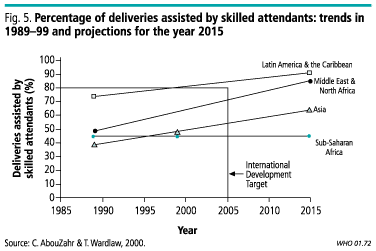
If the validity of using process indicators to monitor trends in maternal mortality is accepted, we must conclude that while there have been modest improvements in Asia, the Middle East, and North Africa it is likely that levels of maternal mortality in sub-Saharan African countries have remained unchanged or have even deteriorated. 
Acknowledgements
The authors wish to thank Nyein Nyein Lwin and Elisabeth Aahman for their assistance in compiling these data.
Conflicts of interest: none declared.
Résumé
La mortalité maternelle à la fin dune décennie: des signes de progrès?
La mortalité maternelle est une mesure importante de la santé des femmes et donne une indication de la performance des systèmes de santé. Plusieurs conférences internationales, dont le Sommet du Millénaire en 2000, ont inscrit à leur ordre du jour lobjectif de la réduction de la mortalité maternelle. Cependant, la surveillance des progrès réalisés savère problématique car la mortalité maternelle est difficile à mesurer, notamment dans les pays en développement où les systèmes dinformation sanitaire et denregistrement des données démographiques sont insuffisants. Cest pourquoi lon sest intéressé à lutilisation dindicateurs de remplacement. Larticle examine les tendances récentes de deux indicateurs associés à la mortalité maternelle, le pourcentage daccouchements réalisés par un agent de santé qualifié et la proportion daccouchements par césarienne. A léchelle mondiale, on note une augmentation modeste de la proportion daccouchements réalisés par un personnel qualifié, avec une augmentation annuelle moyenne de 1,7% pendant la période 1989-1999. Les progrès les plus importants ont été observés en Asie, au Moyen-Orient et en Afrique du Nord, avec une augmentation annuelle de plus de 2%. En Afrique subsaharienne, par contre, la couverture na guère évolué. En général, la proportion daccouchements par césarienne est restée stable au cours des années 90. Les pays dans lesquels les taux de césariennes étaient les plus faibles et où les besoins étaient les plus grands sont ceux où la situation a le moins changé. Cette analyse nous amène à conclure que si les tendances de la mortalité maternelle autorisent un certain optimisme dans certaines parties de lAfrique du Nord, de lAmérique latine, de lAsie et du Moyen-Orient, la situation en Afrique subsaharienne reste préoccupante.
Resumen
La mortalidad materna al término de una década: ¿hay indicios de progreso?
La mortalidad materna es un indicador de la salud de la mujer y una variable indicativa del desempeño de los sistemas de atención de salud. Varias conferencias internacionales, la más reciente de las cuales es la Cumbre del Milenio celebrada en 2000, han incluido entre sus objetivos la reducción de la mortalidad materna. Sin embargo, el seguimiento de los progresos hacia esa meta ha sido problemático, pues la mortalidad materna es difícil de medir, especialmente en los países en desarrollo, caracterizados por la precariedad de sus sistemas de información sanitaria y de registro civil. Esto ha despertado el interés por el uso de indicadores alternativos para vigilar los progresos. En este artículo se examinan las tendencias recientes en lo que atañe a dos indicadores asociados a la mortalidad materna: el porcentaje de partos atendidos por un agente de salud debidamente capacitado para ello, y las tasas de parto por cesárea. A nivel mundial se ha registrado una leve mejora de la cobertura de atención cualificada al parto, con un aumento promedio del 1,7% anual durante el periodo 19891999. Los progresos han sido mayores en Asia, Oriente Medio y África septentrional, con aumentos anuales de más del 2%. En el África subsahariana, en cambio, la cobertura se ha estancado. En general, las tasas de parto por cesárea se mantuvieron estables durante los años noventa. Los países con las tasas más bajas de parto por cesárea y con las mayores necesidades fueron los que registraron la menor variación. Este análisis nos lleva a concluir que, aunque quizá hay motivos para ser optimistas respecto a las tendencias de la mortalidad materna en zonas del norte de África y en América Latina, Asia y Oriente Medio, la situación en el África subsahariana sigue siendo preocupante.
References
1. Report of the Ad Hoc Committee of the Whole of the Twenty-first Special Session of the General Assembly, A/S-21/5/1Add1. New York, United Nations, 1999.
2. Shaping the 21st century: the contribution of development cooperation. Paris, Organisation for Economic Cooperation and Development, 1996.
3. A better world for all: progress towards the international development goals. Washington, DC, International Monetary Fund; Paris, Organisation for Economic Cooperation and Development; New York, United Nations; and Washington, DC, World Bank, 2000.
4. The millennium declarations, Resolution A/RES/55/2. New York, United Nations, 2000.
5. Campbell OMA, Graham WJ. Measuring maternal mortality and morbidity: levels and trends. London, London School of Hygiene and Tropical Medicine, 1990.
6. International statistical classification of diseases and related health problems. Tenth revision. Geneva, World health Organization, 1992.
7. Bouvier-Colle MH et al. Reasons for the underreporting of maternal mortality in France, as indicated by a survey of all deaths among women of childbearing age. International Journal of Epidemiology, 1991, 20: 717721.
8. Hibbard BM et al. Confidential enquiries into maternal deaths in the United Kingdom, 19881990. London, Her Majestys Stationery Office, 1994.
9. Smith JC et al. An assessment of the incidence of maternal mortality in the United States. American Journal of Public Health, 1984, 74 (8): 780783.
10. Thonneau P et al. Risk factors for maternal mortality: results of a case-control study conducted in Conakry (Guinea). International Journal of Gynaecology and Obstetrics, 1992, 39: 8792.
11. Child survival project. Cairo, Ministry of Health, 1994.
12. Agoestina T, Soejoenoes A. Technical report on the study of maternal and perinatal mortality, Central Java Province. Jakarta, Ministry of Health, 1989.
13. Graham W, Brass W, Snow RW. Indirect estimation of maternal mortality: the sisterhood method. Studies in Family Planning, 1989, 20: 125135.
14. Atrash H, Alexander S, Berg C. Maternal mortality in developed countries: not just a concern of the past. Obstetrics and Gynecology, 1995, 86 (4, Part 2): 700705.
15. Turnbull A et al. Report on confidential enquiries into maternal deaths in England and Wales 198284. London, Her Majestys Stationery Office, 1989.
16. Maternal mortality surveillance Puerto Rico 1989. Mortality and Morbidity Weekly Report, 1991, 40: 521513.
17. Hibbard BM et al. Report on confidential enquiries into maternal deaths in the United Kingdom 19911993. London, Her Majestys Stationery Office, 1996.
18. WHO/UNICEF/UNFPA. Americas Region consultation on maternal mortality estimates, Washington, DC, 2022 April 1998 [report] .Geneva, World Health Organization, 1998 (unpublished document WHO/RHT/98.27).
19. Royston E, Armstrong S, eds. Preventing maternal deaths. Geneva, World Health Organization, 1989.
20. Reduction of maternal mortality: a joint WHO/UNFPA/ UNICEF/ World Bank statement. Geneva, World Health Organization, 1999.
21. De Browere V, Tonglet R, Van Lerberghe W. Strategies for reducing maternal mortality in developing countries: what can we learn from the history of the industrialised West? Tropical Medicine and International Health, 1998, 3 (10): 771782.
22. WHO Reproductive Health Library, No. 2. Geneva, World Health Organization, 1999 (computer disk).
23. Graham WJ, Bell JS, Bullough CHW. Can skilled attendance at delivery reduce maternal mortality in developing countries? Paper presented at: European Commission Expert Meeting on Safer Motherhood, Brussels, Belgium, 2728 November 2000.
24. UNICEF/WHO/UNFPA. Guidelines for monitoring the availability and use of obstetric services. New York, UNICEF, 1997.
1 Coordinator, Policy, Planning, and Evaluation, Office of the Executive Director, Family and Reproductive Health, World Health Organization, 1211 Geneva 27, Switzerland. Correspondence should be addressed to this author.
2 Senior Project Officer, Statistics and Monitoring, UNICEF, New York, USA.
Ref. No. 00-0498
